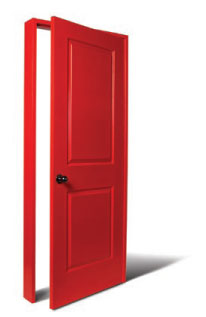Thanks for your interest in The Customer Development Book! Here’s an excerpt…
Sample Chapter: False Door Experiments
You and your co-founder are fighting.

You’re working on a cooking app together and you’re arguing over when to implement the, “Look What I Cooked!” feature. This feature is awesome!
It enables users to take a picture of what they cooked using your app and post it on Facebook (with a link back to your app).
You’re stoked about the feature because it feels like viral gold, but your co-founder, who doesn’t even use Facebook, says it’s a lot of work to implement. She’d much rather implement recipe rating first.
So which feature should you implement first? You could argue until someone quits, you could play rock, paper, scissors, or…you can place a friendly co-founder wager and let your customers decide.
Enter, the False Door Experiment
A False Door Experiment is a crazy quick experiment that offers customers something interesting on the other side of a door, and then measures how often they try to open it.
In this case, you might decide to add a “Look what I Cooked!” button at the bottom of recipe and measure what percentage of your users actually touch the button. If no one touches the button, far better to know now than after making your co-founder write all that code against her will.
You can even go a step further to resolve the dispute, you could A/B test your False Door Experiment. You could give half of your users a false door measuring the “Look what I Cooked!” button, and the other half a set of Recipe Rating Stars and measure which feature gets more clicks.
Whichever false door gets opened the most is the feature you implement first!
What’s Behind the False Door?
So what do you tell users when they try to use a feature that doesn’t exist? You’ve got choices, here. You could say,
- “Oops, we’ve encountered an error. We’ve told our support team about it and they’ll be looking into it as soon as possible.”
- “This feature is coming soon! We’ll let you know as soon as its available.”
- “Thank you for your input! This was an experiment to see how many of our users want this feature – glad to see you’re one of them! We’ll let you know as soon as it’s available.”
Or you could also say nothing.
In the case of the Recipe Rating for your cooking app, you could simple say, “Thank you!” once someone votes and do nothing with the data (i.e. don’t send the actual ratings to your server, don’t put them in your database, etc.).
Another Example
Imagine you knew someone who loved teaching founders about Customer Development. Now imagine he was curious if his blog readers wanted a Customer Development Book.
This person may decide to put a link to a hypothetical “The Customer Development Book” on his blog, measure how many people click that link, and how many people sign up for email updates on the book, to determine whether he should write that book.
He’d put a form like this, encouraging people to sign-up if they wanted updates on his potential book (and he might even offer them something special as being a part of the experiment :)
If someone did something like that, it would be an awesome example of a false door experiment. :)













